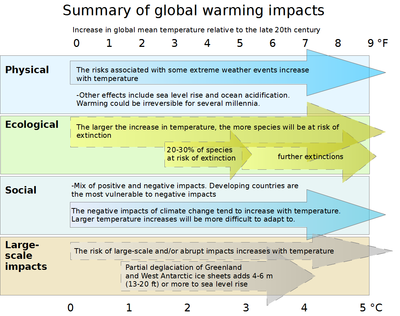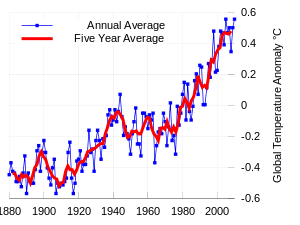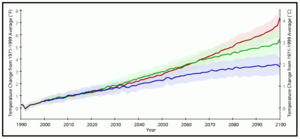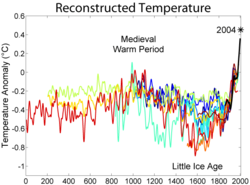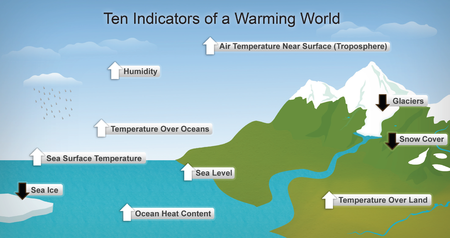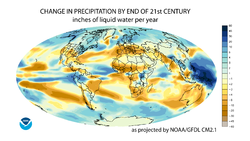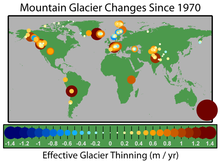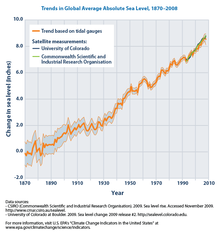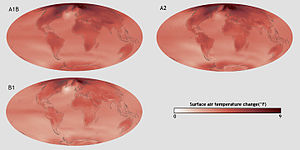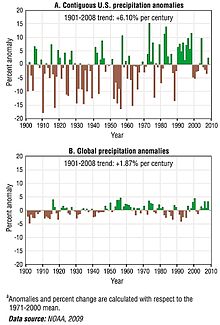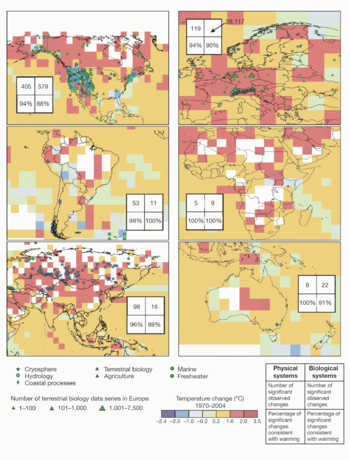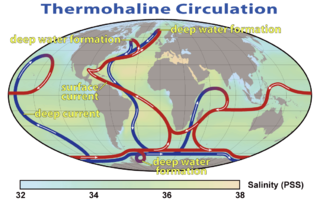
Effects of global warming
Did you know...
SOS Children, an education charity, organised this selection. To compare sponsorship charities this is the best sponsorship link.
The effects of global warming are the ecological and social changes caused by the rise in global temperatures. There is a scientific consensus that climate change is occurring, and that human activities are the primary driver. Evidence of climate change includes the instrumental temperature record, rising sea levels, and decreased snow cover in the Northern Hemisphere. According to the Intergovernmental Panel on Climate Change (IPCC), most of the observed increase in global average temperatures since the mid-20th century is very likely due to the observed increase in human greenhouse gas concentrations.
Projections of future climate change suggest further global warming, sea level rise, and an increase in the frequency and severity of some extreme weather events. Parties to the United Nations Framework Convention on Climate Change (UNFCCC) have agreed to "stabilize greenhouse gas concentrations in the atmosphere at a level that would prevent dangerous anthropogenic interference with the climate system."
Definitions
In this article, "climate change" means a change in climate that persists over a sustained period of time. The World Meteorological Organization defines this time period as 30 years. Examples of climate change include increases in global surface temperature (global warming), changes in rainfall patterns, and changes in the frequency of extreme weather events. Changes in climate may be due to natural causes, e.g., changes in the sun's output, or due to human activities, e.g., changing the composition of the atmosphere. Any human-induced changes in climate will occur against the "background" of natural climatic variations.
Also, the term "anthropogenic forcing" refers to the influence exerted on a habitat or chemical environment by humans, as opposed to a natural process.
Temperature changes
This article breaks down some of the impacts of climate change according to different levels of future global warming. This way of describing impacts has, for instance, been used in the IPCC's Assessment Reports on climate change. The instrumental temperature record shows global warming of around 0.6 °C over the entire 20th century.
SRES emissions scenarios
The future level of global warming is uncertain, but a wide range of estimates (projections) have been made. The IPCC's " SRES" scenarios have been frequently used to make projections of future climate change. The SRES scenarios are " baseline" (or "reference") scenarios, which means that they do not take into account any current or future measures to limit GHG emissions (e.g., the UNFCCC's Kyoto Protocol and the Cancún agreements). Emissions projections of the SRES scenarios are broadly comparable in range to the baseline emissions scenarios that have been developed by the scientific community.
In the IPCC Fourth Assessment Report, changes in future global mean temperature were projected using the six SRES "marker" emissions scenarios. Emissions projections for the six SRES "marker" scenarios are representative of the full set of forty SRES scenarios. For the lowest emissions SRES marker scenario ("B1" - see the SRES article for details on this scenario), the best estimate for global mean temperature is an increase of 1.8 °C (3.2 °F) by the end of the 21st century. This projection is relative to global temperatures at the end of the 20th century. The "likely" range (greater than 66% probability, based on expert judgement) for the SRES B1 marker scenario is 1.1–2.9 °C (2–5.2 °F). For the highest emissions SRES marker scenario (A1FI), the best estimate for global mean temperature increase is 4.0 °C (7.2 °F), with a "likely" range of 2.4–6.4 °C (4.3–11.5 °F).
The range in temperature projections partly reflects (1) the choice of emissions scenario, and (2) the " climate sensitivity." For (1), different scenarios make different assumptions of future social and economic development (e.g., economic growth, population level, energy policies), which in turn affects projections of greenhouse gas (GHG) emissions. The projected magnitude of warming by 2100 is closely related to the level of cumulative emissions over the 21st century (i.e., total emissions between 2000-2100). The higher the cumulative emissions over this time period, the greater the level of warming is projected to occur.
(2) reflects uncertainty in the response of the climate system to past and future GHG emissions, which is measured by the climate sensitivity). Higher estimates of climate sensitivity lead to greater projected warming, while lower estimates of climate sensitivity lead to less projected warming.
Over the next several millennia, projections suggest that global warming could be irreversible. Even if emissions were drastically reduced, global temperatures would remain close to their highest level for at least 1,000 years (see the later section on irreversibilities).
Projected warming in context
Scientists have used various "proxy" data to assess past changes in Earth's climate ( paleoclimate). Sources of proxy data include historical records (such as farmers' logs), tree rings, corals, fossil pollen, ice cores, and ocean and lake sediments. Analysis of these data suggest that recent warming is unusual in the past 400 years, possibly longer. By the end of the 21st century, temperatures may increase to a level not experienced since the mid-Pliocene, around 3 million years ago. At that time, models suggest that mean global temperatures were about 2–3 °C warmer than pre-industrial temperatures. Even a 2 °C rise above the pre-industrial level would be outside the range of temperatures experienced by human civilization.
Physical impacts
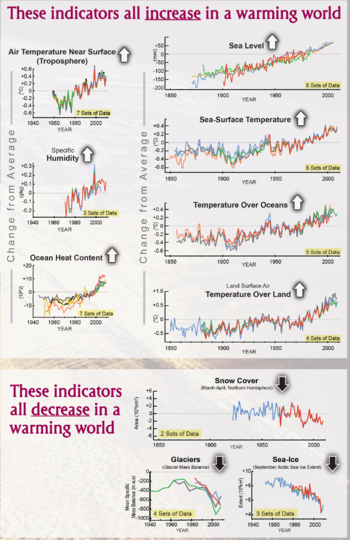
A broad range of evidence shows that the climate system has warmed. Evidence of global warming is shown in the graphs opposite. Some of the graphs show a positive trend, e.g., increasing temperature over land and the ocean, and sea level rise. Other graphs show a negative trend, e.g., decreased snow cover in the Northern Hemisphere, and declining Arctic sea ice extent. Evidence of warming is also apparent in living (biological) systems.
Human activities have contributed to a number of the observed changes in climate. This contribution has principally been through the burning of fossil fuels, which has led to an increase in the concentration of GHGs in the atmosphere. Another human influence on the climate are sulfur dioxide emissions, which are a precursor to the formation of sulfate aerosols in the atmosphere.
Human-induced warming could lead to large-scale, irreversible, and/or abrupt changes in physical systems. An example of this is the melting of ice sheets, which contributes to sea level rise. The probability of warming having unforeseen consequences increases with the rate, magnitude, and duration of climate change.
Radiative forcing
The effect of human activities on the climate system can be measured by radiative forcing. A positive radiative forcing will tend to warm the climate, while a negative forcing will tend to cool the climate. Anthopogenic forcing (i.e., the radiative forcing due to human activities) was estimated to have been positive (i.e., an overall warming effect) in the year 2005. This is relative to the estimated forcings at the start of the industrial era, taken as the year 1750. Anthropogenic forcing of the climate has likely contributed to a number of observed changes, including sea level rise, changes in climate extremes (such as warm and cold days), declines in Arctic sea ice extent, and to glacier retreat.
Effects on weather
Observations show that there have been changes in weather. As climate changes, the probabilities of certain types of weather events are affected.
Changes have been observed in the amount, intensity, frequency, and type of precipitation. Widespread increases in heavy precipitation have occurred, even in places where total rain amounts have decreased. With medium confidence (see footnote 1), IPCC (2012) concluded that human influences had contributed to an increase in heavy precipitation events at the global scale.
Projections of future changes in precipitation show overall increases in the global average, but with substantial shifts in where and how precipitation falls. Projections suggest a reduction in rainfall in the subtropics, and an increase in precipitation in subpolar latitudes and some equatorial regions. In other words, regions which are dry at present will in general become even drier, while regions that are currently wet will in general become even wetter. This projection does not apply to every locale, and in some cases can be modified by local conditions.
Extreme weather
Since the 1950s, it is very likely that the number of cold days and nights have decreased globally. There have been other changes in climate extremes, e.g., floods and tropical cyclones, but these changes are more difficult to identify. As previously stated, human influences appear to have contributed to some of the observed changes.
Future climate change will very likely be associated with more very hot days and fewer very cold days. The frequency, length and intensity of heat waves will very likely increase over most land areas. It's likely that the average maximum wind speed of tropical cyclones will increase, though there may also be fewer cyclones. A number of regions may experience more intense droughts, including southern Europe and the Mediterranean region, central Europe, central North America, Central America and Mexico, Northwest Brazil, and southern Africa. Increases in heavy rainfall might contribute to increases in local flooding in some catchments or regions. In coastal regions, sea level rise will very likely contribute to extremes in sea level.
The impacts of extreme events on the environment and human society will vary. Some impacts will be beneficial -- e.g., fewer cold extremes will probably lead to fewer cold deaths. Overall, however, impacts will probably be mostly negative.
Glacier retreat and disappearance
Authors of the IPCC Fourth Assessment Report (AR4) found that, on average, mountain glaciers and snow cover had decreased in both the northern and southern hemispheres. This widespread decrease in glaciers and ice caps had contributed to observed sea level rise. With very high or high confidence, authors of the IPCC Working Group II Assessment (IPCC AR4 WG2 2007) and Synthesis Report (IPCC AR4 SYR 2007) made a number of projections relating to future changes in glaciers:
- Mountainous areas in Europe will face glacier retreat
- In Polar regions, there will be reductions in glacier extent and the thickness of glaciers.
- More than one-sixth of the world's population are supplied by meltwater from major mountain ranges. Changes in glaciers and snow cover are expected to reduce water availability for these populations.
- In Latin America, changes in precipitation patterns and the disappearance of glaciers will significantly affect water availability for human consumption, agriculture, and energy production.
Geology
Volcanoes
The retreat of glaciers and ice caps can cause increased volcanism. Reduction in ice cover reduces the confining pressure exerted on the volcano, increasing deviatoric stresses and potentially causing the volcano to erupt. This reduction of pressure can also cause decompression melting of material in the mantle, resulting in the generation of more magma. Researchers in Iceland have shown that the rate of volcanic rock production there following deglaciation (10,000 to 4500 years before present) was 20–30 times greater than that observed after 2900 years before present. While the original study addresses the first reason for increased volcanism (reduced confining pressure), scientists have more recently shown that these lavas have unusually high trace element concentrations, indicative of increased melting in the mantle. This work in Iceland has been corroborated by a study in California, in which scientists found a strong correlation between volcanism and periods of global deglaciation. The effects of current sea level rise could include increased crustal stress at the base of coastal volcanoes from a rise in the volcano's water table (and the associated saltwater intrusion), while the mass from extra water could activate dormant seismic faults around volcanoes. In addition, the wide-scale displacement of water from melting in places such as West Antarctica is likely to slightly alter the Earth's rotational period and may shift its axial tilt on the scale of hundreds of metres, inducing further crustal stress changes.
Current melting of ice is predicted to increase the size and frequency of volcanic eruptions. In particular, lateral collapse events at stratovolcanoes are likely to increase, and there are potential positive feedbacks between the removal of ice and magmatism.
Earthquakes
A numerical modeling study has demonstrated that seismicity increases during unloading, such as that due to the removal of ice.
Oceans
The role of the oceans in global warming is a complex one. The oceans serve as a sink for carbon dioxide, taking up much that would otherwise remain in the atmosphere, but increased levels of CO2 have led to ocean acidification. Furthermore, as the temperature of the oceans increases, they become less able to absorb excess CO2. The ocean have also acted as a sink in absorbing extra heat from the atmosphere. The increase in ocean heat content is much larger than any other store of energy in the Earth’s heat balance over the two periods 1961 to 2003 and 1993 to 2003, and accounts for more than 90% of the possible increase in heat content of the Earth system during these periods.
Global warming is projected to have a number of effects on the oceans. Ongoing effects include rising sea levels due to thermal expansion and melting of glaciers and ice sheets, and warming of the ocean surface, leading to increased temperature stratification. Other possible effects include large-scale changes in ocean circulation.
Acidification
About one-third of the carbon dioxide emitted by human activity has already been taken up by the oceans. As carbon dioxide dissolves in sea water, carbonic acid is formed, which has the effect of acidifying the ocean, measured as a change in pH. The uptake of human carbon emissions since the year 1750 has led to an average decrease in pH of 0.1 units. Projections using the SRES emissions scenarios suggest a further reduction in average global surface ocean pH of between 0.14 and 0.35 units over the 21st century.
The effects of ocean acidification on the marine biosphere have yet to be documented. Laboratory experiments suggest beneficial effects for a few species, with potentially highly detrimental effects for a substantial number of species. With medium confidence, Fischlin et al. (2007) projected that future ocean acidification and climate change would impair a wide range of planktonic and shallow benthic marine organisms that use aragonite to make their shells or skeletons, such as corals and marine snails ( pteropods), with significant impacts particularly in the Southern Ocean.
Oxygen depletion
The amount of oxygen dissolved in the oceans may decline, with adverse consequences for ocean life.
Sea level rise
There is strong evidence that global sea level rose gradually over the 20th century. With high confidence, Bindoff et al. (2007) concluded that between the mid-19th and mid-20th centuries, the rate of sea level rise increased. Authors of the IPCC Fourth Assessment Synthesis Report (IPCC AR4 SYR, 2007) reported that between the years 1961 and 2003, global average sea level rose at an average rate of 1.8 mm per year (mm/yr), with a range of 1.3–2.3 mm/yr. Between 1993 and 2003, the rate increased above the previous period to 3.1 mm/yr (range of 2.4–3.8 mm/yr). Authors of IPCC AR4 SYR (2007) were uncertain whether the increase in rate from 1993 to 2003 was due to natural variations in sea level over the time period, or whether it reflected an increase in the underlying long-term trend.
There are two main factors that have contributed to observed sea level rise. The first is thermal expansion: as ocean water warms, it expands. The second is from the contribution of land-based ice due to increased melting. The major store of water on land is found in glaciers and ice sheets. Anthropogenic forcing very likely (greater than 90% probability, based on expert judgement) contributed to sea level rise during the latter half of the 20th century.
There is a widespread consensus that substantial long-term sea level rise will continue for centuries to come. In their Fourth Assessment Report, the IPCC projected sea level rise to the end of the 21st century using the SRES emissions scenarios. Across the six SRES marker scenarios, sea level was projected to rise by 18 to 59 cm (7.1 to 23.2 in), relative to sea level at the end of the 20th century. Thermal expansion is the largest component in these projections, contributing 70-75% of the central estimate for all scenarios. Due to a lack of scientific understanding, this sea level rise estimate does not include all of the possible contributions of ice sheets (see the section on abrupt or irreversible changes).
An assessment of the scientific literature on climate change was published in 2010 by the US National Research Council (NRC, 2010). NRC (2010) described the projections in AR4 (i.e., those cited in the above paragraph) as "conservative," and summarized the results of more recent studies. Cited studies suggested a great deal of uncertainty in projections. A range of projections suggested possible sea level rise by the end of the 21st century of between 0.56 and 2 m, relative to sea levels at the end of the 20th century.
Ocean temperature rise
From 1961 to 2003, the global ocean temperature has risen by 0.10 °C from the surface to a depth of 700 m. There is variability both year-to-year and over longer time scales, with global ocean heat content observations showing high rates of warming for 1991–2003, but some cooling from 2003 to 2007. The temperature of the Antarctic Southern Ocean rose by 0.17 °C (0.31 °F) between the 1950s and the 1980s, nearly twice the rate for the world's oceans as a whole. As well as having effects on ecosystems (e.g. by melting sea ice, affecting algae that grow on its underside), warming reduces the ocean's ability to absorb CO2. It is likely (greater than 66% probability, based on expert judgement) that anthropogenic forcing contributed to the general warming observed in the upper several hundred metres of the ocean during the latter half of the 20th century.
Regions
Regional effects of global warming vary in nature. Some are the result of a generalised global change, such as rising temperature, resulting in local effects, such as melting ice. In other cases, a change may be related to a change in a particular ocean current or weather system. In such cases, the regional effect may be disproportionate and will not necessarily follow the global trend.
There are three major ways in which global warming will make changes to regional climate: melting or forming ice, changing the hydrological cycle (of evaporation and precipitation) and changing currents in the oceans and air flows in the atmosphere. The coast can also be considered a region, and will suffer severe impacts from sea level rise.
Observed impacts
With very high confidence, Rosenzweig et al. (2007) concluded that physical and biological systems on all continents and in most oceans had been affected by recent climate changes, particularly regional temperature increases. Impacts include earlier leafing of trees and plants over many regions; movements of species to higher latitudes and altitudes in the Northern Hemisphere; changes in bird migrations in Europe, North America and Australia; and shifting of the oceans' plankton and fish from cold- to warm-adapted communities.
The human influence on the climate can be seen in the geographical pattern of observed warming, with greater temperature increases over land and in polar regions rather than over the oceans. Using models, it is possible to identify the human "signal" of global warming over both land and ocean areas.
Projected impacts
Projections of future climate changes at the regional scale do not hold as high a level of scientific confidence as projections made at the global scale. It is, however, expected that future warming will follow a similar geographical pattern to that seen already, with greatest warming over land and high northern latitudes, and least over the Southern Ocean and parts of the North Atlantic Ocean. Nearly all land areas will very likely warm more than the global average.
The Arctic, Africa, small islands and Asian megadeltas are regions that are likely to be especially affected by climate change. Adverse impacts of climate change are expected to fall disproportionately upon developing countries. Within other areas, even those with high incomes, some people can be particularly at risk from climate change, such as the poor, young children and the elderly.
Social systems
The impacts of climate change can be thought of in terms of sensitivity and vulnerability. "Sensitivity" is the degree to which a particular system or sector might be affected, positively or negatively, by climate change and/or climate variability. "Vulnerability" is the degree to which a particular system or sector might be adversely affected by climate change.
The sensitivity of human society to climate change varies. Sectors sensitive to climate change include water resources, coastal zones, human settlements, and human health. Industries sensitive to climate change include agriculture, fisheries, forestry, energy, construction, insurance, financial services, tourism, and recreation.
Food supply
Climate change will impact agriculture and food production around the world due to: the effects of elevated CO2 in the atmosphere, higher temperatures, altered precipitation and transpiration regimes, increased frequency of extreme events, and modified weed, pest, and pathogen pressure. In general, low-latitude areas are at most risk of having decreased crop yields.
So far, the effects of regional climate change on agriculture have been relatively limited. Changes in crop phenology provide important evidence of the response to recent regional climate change. Phenology is the study of natural phenomena that recur periodically, and how these phenomena relate to climate and seasonal changes. A significant advance in phenology has been observed for agriculture and forestry in large parts of the Northern Hemisphere.
Projections
With low to medium confidence, Schneider et al. (2007) projected that for about a 1 to 3 °C increase in global mean temperature (by the years 2090-2100, relative to temperature in the years 1990–2000), there would be productivity decreases for some cereals in low latitudes, and productivity increases in high latitudes. With medium confidence, global production potential was projected to:
- increase up to around 3 °C,
- very likely decrease above about 3 °C.
Most of the studies on global agriculture assessed by Schneider et al. (2007) had not incorporated a number of critical factors, including changes in extreme events, or the spread of pests and diseases. Studies had also not considered the development of specific practices or technologies to aid adaptation to climate change.
Food security
Easterling et al. (2007) assessed studies that made quantitative projections of climate change impacts on food security. It was noted that these projections were highly uncertain and had limitations. However, the assessed studies suggested a number of fairly robust findings. The first was that climate change would likely increase the number of people at risk of hunger compared with reference scenarios with no climate change. Climate change impacts depended strongly on projected future social and economic development. Additionally, the magnitude of climate change impacts was projected to be smaller compared to the impact of social and economic development. In 2006, the global estimate for the number of people undernourished was 820 million. Under the SRES A1, B1, and B2 scenarios (see the SRES article for information on each scenario group), projections for the year 2080 showed a reduction in the number of people undernourished of about 560-700 million people, with a global total of undernourished people of 100-240 million in 2080. By contrast, the SRES A2 scenario showed only a small decrease in the risk of hunger from 2006 levels. The smaller reduction under A2 was attributed to the higher projected future population level in this scenario. By 2012, observed droughts in North America had become more severe than any of the IPCC AR4 or SRES projections, and they are expected to persist and worsen.
Agriculture
Droughts have been occurring more frequently because of global warming and they are expected to become more frequent and intense in Africa, southern Europe, the Middle East, most of the Americas, Australia, and Southeast Asia. Their impacts are aggravated because of increased water demand, population growth, urban expansion, and environmental protection efforts in many areas. Droughts result in crop failures and the loss of pasture grazing land for livestock.
Health
Human beings are exposed to climate change through changing weather patterns (temperature, precipitation, sea-level rise and more frequent extreme events) and indirectly through changes in water, air and food quality and changes in ecosystems, agriculture, industry and settlements and the economy (Confalonieri et al., 2007:393). According to an assessment of the scientific literature by Confalonieri et al. (2007:393), the effects of climate change to date have been small, but are projected to progressively increase in all countries and regions.
A study by the World Health Organization (WHO, 2009) estimated the effect of climate change on human health. Not all of the effects of climate change were included in their estimates, for example, the effects of more frequent and extreme storms were excluded. Climate change was estimated to have been responsible for 3% of diarrhoea, 3% of malaria, and 3.8% of dengue fever deaths worldwide in 2004. Total attributable mortality was about 0.2% of deaths in 2004; of these, 85% were child deaths.
Projections
With high confidence, authors of the IPCC AR4 Synthesis report projected that climate change would bring some benefits in temperate areas, such as fewer deaths from cold exposure, and some mixed effects such as changes in range and transmission potential of malaria in Africa. Benefits were projected to be outweighed by negative health effects of rising temperatures, especially in developing countries.
With very high confidence, Confalonieri et al. (2007) concluded that economic development was an important component of possible adaptation to climate change. Economic growth on its own, however, was not judged to be sufficient to insulate the world's population from disease and injury due to climate change. Future vulnerability to climate change will depend not only on the extent of social and economic change, but also on how the benefits and costs of change are distributed in society. For example, in the 19th century, rapid urbanization in western Europe lead to a plummeting in population health. Other factors important in determining the health of populations include education, the availability of health services, and public-health infrastructure.
Specific health impacts
Malnutrition
With high confidence, Confalonieri et al. (2007) projected that malnutrition would increase due to climate change. This link is associated with climate variability and change. Drought reduces variety in diets and reduces overall consumption. This can lead to micronutrient deficiencies.
The World Health Organization (Campbell-Lendrum et al., 2003) conducted a regional and global assessment to quantify the amount of premature morbidity and mortality due to a range of factors, including climate change. Projections were made over future climate change impacts. Limited adjustments for adaptation were included in the estimates based on these projections. Projected relative risks attributable to climate change in 2030 varied by health outcome and region. Risks were largely negative, with most of the projected disease burden due to increases in diarrhoeal disease and malnutrition. These increases were primarily in low-income populations already experiencing a large burden of disease.
Extreme events
With high confidence, Confalonieri et al. (2007) projected that climate change would increase the number of people suffering from death, disease and injury from heatwaves, floods, storms, fires and droughts.
- Floods and weather disasters
Floods are low-probability, high-impact events that can overwhelm physical infrastructure and human communities. Confalonieri et al. (2007) reported that major storm and flood disasters have occurred in the last two decades.
The impacts of weather disasters is considerable and unequally distributed. For example, natural disasters have been shown to result in increased domestic violence against - and post-traumatic stress disorders in – women. In terms of deaths and populations affected, floods and tropical cyclones have the greatest impact in South Asia and Latin America. Vulnerability to weather disasters depends on the attributes of the person at risk, including where they live and their age, as well as other social and environmental factors. High-density populations in low-lying coastal regions experience a high health burden from weather disasters.
- Heatwaves
Hot days, hot nights and heatwaves have become more frequent. Heatwaves are associated with marked short-term increases in mortality. For example, in August 2003, a heatwave in Europe resulted in excess mortality in the range of 35,000 total deaths.
Heat-related morbidity and mortality is projected to increase. The health burden could be relatively small for moderate heatwaves in temperate regions, because deaths occur primarily in susceptible persons.
- Drought
The effects of drought on health include deaths, malnutrition, infectious diseases and respiratory diseases. Countries within the "Meningitis Belt" in semi-arid sub-Saharan Africa experience the highest endemicity and epidemic frequency of meningococcal meningitis in Africa, although other areas in the Rift Valley, the Great Lakes, and southern Africa are also affected. The spatial distribution, intensity, and seasonality of meningococcal (epidemic) meningitis appear to be strongly linked to climate and environmental factors, particularly drought. The cause of this link is not fully understood.
- Fires
In some regions, changes in temperature and precipitation are projected to increase the frequency and severity of fire events. Forest and bush fires cause burns, damage from smoke inhalation and other injuries.
Infectious disease vectors
With high confidence, Confalonieri et al. (2007) projected that climate change would continue to change the range of some infectious disease vectors. Vector-borne diseases (VBD) are infections transmitted by the bite of infected arthropod species, such as mosquitoes, ticks, triatomine bugs, sandflies, and blackflies. There is some evidence of climate-change-related shifts in the distribution of tick vectors of disease, of some (non-malarial) mosquito vectors in Europe and North America. Climate change has also been implicated in changes in the breeding and migration dates of several bird species. Several species of wild bird can act as carriers of human pathogens as well as of vectors of infectious agents.
Dengue
With low confidence, Confalonieri et al. (2007) concluded that climate change would increase the number of people at risk of dengue. Dengue is the world's most important vector-borne viral disease. Several studies have reported associations between dengue and climate, however, these associations are not entirely consistent.
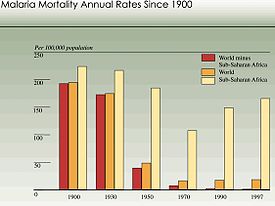
Malaria
The spatial distribution, intensity of transmission, and seasonalty of malaria is influenced by climate in Sub-saharan Africa. Rainfall can be a limiting factor for mosquito populations and there is some evidence of reductions in transmission associated with decadal decreases in rainfall. The effects of observed climate change on the geographical distribution of malaria and its transmission intensity in highland regions remains controversial. There is no clear evidence that malaria has been affected by climate change in South America or in continental regions of the Russian Federation. There is still much uncertainty about the potential impact of climate change on malaria at local and global scales.
A paper by researchers from the University of Oxford and the University of Florida published in Nature in May 2010 concluded that claims that a warming climate has led to more widespread disease and death due to malaria are largely at odds with the evidence, and that "predictions of an intensification of malaria in a warmer world, based on extrapolated empirical relationships or biological mechanisms, must be set against a context of a century of warming that has seen marked global declines in the disease and a substantial weakening of the global correlation between malaria endemicity and climate."
Other infectious diseases
There is good evidence that diseases transmitted by rodents sometimes increase during heavy rainfall and flooding because of altered patterns of human-pathogen-rodent contact.
Projections
With very high confidence, Confalonieri et al. (2007) concluded that climate change would have mixed effects on malaria. Malaria is a complex disease to model and all of the published models assessed by Confalonieri et al. (2007) had limited parametrization of some key factors. Parametrization is used in climate models because the resolution of models is insufficient to resolve some physical processes. Given this limitation, models assessed by Confalonieri et al. (2007) projected that, particularly in Africa, climate change would be associated with geographical expansions of the areas suitable for Plasmodium falciparum malaria in some regions, and contractions in other regions. Projections also suggested that some regions would experience a longer season of transmission. Projections suggested expansions in vector species that carry dengue for parts of Australia and New Zealand.
Diarrhoeal diseases
With medium confidence, Confalonieri et al. (2007) concluded that climate change would increase the burden of diarrhoeal diseases. Childhood mortality due to diarrhoea in low-income countries, especially in Sub-Saharan Africa, remains high. This is despite improvements in care. Several studies have shown that transmission of enteric pathogens is higher during the rainy season. Some studies have found that higher temperature was strongly associated with increased episodes of diarrhoeal disease in adults and children in Peru. Campbell-Lendrum et al. (2003) projected that climate change would increase the burden of diarrhoeal diseases in low-income regions by approximately 2 to 5% in 2020.
Ground-level ozone
With high confidence, Confalonieri et al. (2007) projected that climate change would increase cardio-respiratory morbidity and mortality associated with ground-level ozone. Ground-level ozone is both naturally occurring and is the primary constituent of urban smog. Ozone in smog is formed through chemical reactions involving nitrogen oxides and other compounds. The reaction is a photochemical reaction, meaning that it involves electromagnetic radiation, and occurs in the presence of bright sunshine and high temperatures. Exposure to elevated concentrations of ozone is associated with increased hospital admissions for pneumonia, chronic obstructive pulmonary disease, asthma, allergic rhinitis and other respiratory diseases, and with premature mortality.
Background levels of ground-level ozone have risen since pre-industrial times because of increasing emissions of methane, carbon monoxide and nitrogen oxides. This trend is expected to continue into the mid-21st century.
Cold-waves
Cold-waves continue to be a problem in northern latitudes, where very low temperatures can be reached in a few hours and extend over long periods. Reductions in cold-deaths due to climate change are projected to be greater than increases in heat-related deaths in the UK.
Migration and conflict
General circulation models project that the future climate change will bring wetter coasts, drier mid-continent areas, and further sea level rise. Such changes could result in the gravest effects of climate change through sudden human migration. Millions might be displaced by shoreline erosions, river and coastal flooding, or severe drought.
Migration related to climate change is likely to be predominantly from rural areas in developing countries to towns and cities. In the short term climate stress is likely to add incrementally to existing migration patterns rather than generating entirely new flows of people.
It has been argued that environmental degradation, loss of access to resources (e.g., water resources), and resulting human migration could become a source of political and even military conflict. Factors other than climate change may, however, be more important in affecting conflict. For example, Wilbanks et al. (2007) suggested that major environmentally influenced conflicts in Africa were more to do with the relative abundance of resources, e.g., oil and diamonds, than with resource scarcity. Scott et al. (2001) placed only low confidence in predictions of increased conflict due to climate change.
Aggregate impacts
Aggregating impacts adds up the total impact of climate change across sectors and/or regions. Examples of aggregate measures include economic cost (e.g., changes in gross domestic product (GDP) and the social cost of carbon), changes in ecosystems (e.g., changes over land area from one type of vegetation to another), human health impacts, and the number of people affected by climate change. Aggregate measures such as economic cost require researchers to make value judgements over the importance of impacts occurring in different regions and at different times.
Observed impacts
Global losses reveal rapidly rising costs due to extreme weather-related events since the 1970s. Socio-economic factors have contributed to the observed trend of global losses, e.g., population growth, increased wealth. Part of the growth is also related to regional climatic factors, e.g., changes in precipitation and flooding events. It is difficult to quantify the relative impact of socio-economic factors and climate change on the observed trend. The trend does, however, suggest increasing vulnerability of social systems to climate change.
Projected impacts
The total economic impacts from climate change are highly uncertain. With medium confidence, Smith et al. (2001) concluded that world GDP would change by plus or minus a few percent for a small increase in global mean temperature (up to around 2 °C relative to the 1990 temperature level). Most studies assessed by Smith et al. (2001) projected losses in world GDP for a medium increase in global mean temperature (above 2-3 °C relative to the 1990 temperature level), with increasing losses for greater temperature increases. This assessment is consistent with the findings of more recent studies, as reviewed by Hitz and Smith (2004).
Economic impacts are expected to vary regionally. For a medium increase in global mean temperature (2-3 °C of warming, relative to the average temperature between 1990–2000), market sectors in low-latitude and less-developed areas might experience net costs due to climate change. On the other hand, market sectors in high-latitude and developed regions might experience net benefits for this level of warming. A global mean temperature increase above about 2-3 °C (relative to 1990-2000) would very likely result in market sectors across all regions experiencing either declines in net benefits or rises in net costs.
Aggregate impacts have also been quantified in non-economic terms. For example, climate change over the 21st century is likely to adversely affect hundreds of millions of people through increased coastal flooding, reductions in water supplies, increased malnutrition and increased health impacts.
Biological systems
Observed impacts on biological systems
With very high confidence, Rosenzweig et al. (2007) concluded that recent warming had strongly affected natural biological systems. Hundreds of studies have documented responses of ecosystems, plants, and animals to the climate changes that have already occurred. For example, in the Northern Hemisphere, species are almost uniformly moving their ranges northward and up in elevation in search of cooler temperatures. Humans are very likely causing changes in regional temperatures to which plants and animals are responding.
Projected impacts on biological systems
By the year 2100, ecosystems will be exposed to atmospheric CO2 levels substantially higher than in the past 650,000 years, and global temperatures at least among the highest of those experienced in the past 740,000 years. Significant disruptions of ecosystems are projected to increase with future climate change. Examples of disruptions include disturbances such as fire, drought, pest infestation, invasion of species, storms, and coral bleaching events. The stresses caused by climate change, added to other stresses on ecological systems (e.g., land conversion, land degradation, harvesting, and pollution), threaten substantial damage to or complete loss of some unique ecosystems, and extinction of some critically endangered species.
Climate change has been estimated to be a major driver of biodiversity loss in cool conifer forests, savannas, mediterranean-climate systems, tropical forests, in the Arctic tundra, and in coral reefs. In other ecosystems, land-use change may be a stronger driver of biodiversity loss at least in the near-term. Beyond the year 2050, climate change may be the major driver for biodiversity loss globally.
A literature assessment by Fischlin et al. (2007) included a quantitative estimate of the number of the number of species at increased risk of extinction due to climate change. With medium confidence, it was projected that approximately 20 to 30% of plant and animal species assessed so far (in an unbiased sample) would likely be at increasingly high risk of extinction should global mean temperatures exceed a warming of 2 to 3 °C above pre-industrial temperature levels. The uncertainties in this estimate, however, are large: for a rise of about 2 °C the percentage may be as low as 10%, or for about 3 °C, as high as 40%, and depending on biota (all living organisms of an area, the flora and fauna considered as a unit) the range is between 1% and 80%. As global average temperature exceeds 4 °C above pre-industrial levels, model projections suggested that there could be significant extinctions (40-70% of species that were assessed) around the globe.
Assessing whether future changes in ecosystems will be beneficial or detrimental is largely based on how ecosystems are valued by human society. For increases in global average temperature exceeding 1.5 to 2.5 °C (relative to global temperatures over the years 1980-1999) and in concomitant atmospheric CO2 concentrations, projected changes in ecosystems will have predominantly negative consequences for biodiversity and ecosystems goods and services, e.g., water and food supply.
Abrupt or irreversible changes
Physical, ecological and social systems may respond in an abrupt, non-linear or irregular way to climate change. This is as opposed to a smooth or regular response. A quantitative entity behaves "irregularly" when its dynamics are discontinuous (i.e., not smooth), nondifferentiable, unbounded, wildly varying, or otherwise ill-defined. Such behaviour is often termed " singular." Irregular behaviour in Earth systems may give rise to certain thresholds, which, when crossed, may lead to a large change in the system.
Some singularities could potentially lead to severe impacts at regional or global scales. Examples of "large-scale" singularities are discussed in the articles on abrupt climate change, climate change feedback and runaway climate change. It is possible that human-induced climate change could trigger large-scale singularities, but the probabilities of triggering such events are, for the most part, poorly understood.
With low to medium confidence, Smith et al. (2001) concluded that a rapid warming of more than 3 °C above 1990 levels would exceed thresholds that would lead to large-scale discontinuities in the climate system. Since the assessment by Smith et al. (2001), improved scientific understanding provides more guidance for two large-scale singularities: the role of carbon cycle feedbacks in future climate change (discussed below in the section on biogeochemical cycles) and the melting of the Greenland and West Antarctic ice sheets.
Biogeochemical cycles
Climate change may have an effect on the carbon cycle in an interactive "feedback" process. A feedback exists where an initial process triggers changes in a second process that in turn influences the initial process. A positive feedback intensifies the original process, and a negative feedback reduces it. Models suggest that the interaction of the climate system and the carbon cycle is one where the feedback effect is positive.
Using the A2 SRES emissions scenario, Schneider et al. (2007) found that this effect led to additional warming by the years 2090-2100 (relative to the 1990–2000) of 0.1–1.5 °C. This estimate was made with high confidence. The climate projections made in the IPCC Fourth Assessment Report summarized earlier of 1.1–6.4 °C account for this feedback effect. On the other hand, with medium confidence, Schneider et al. (2007) commented that additional releases of GHGs were possible from permafrost, peat lands, wetlands, and large stores of marine hydrates at high latitudes.
Greenland and West Antarctic Ice sheets
With medium confidence, authors of AR4 concluded that with a global average temperature increase of 1–4 °C (relative to temperatures over the years 1990–2000), at least a partial deglaciation of the Greenland ice sheet, and possibly the West Antarctic ice sheets would occur. The estimated timescale for partial deglaciation was centuries to millennia, and would contribute 4 to 6 metres (13 to 20 ft) or more to sea level rise over this period.
The Atlantic Meridional Overturning Circulation
The Atlantic Meridional Overturning Circulation (AMOC) is an important component of the Earth's climate system, characterized by a northward flow of warm, salty water in the upper layers of the Atlantic and a southward flow of colder water in the deep Atlantic. The AMOC is equivalently known as the thermohaline circulation (THC). Potential impacts associated with MOC changes include reduced warming or (in the case of abrupt change) absolute cooling of northern high-latitude areas near Greenland and north-western Europe, an increased warming of Southern Hemisphere high-latitudes, tropical drying, as well as changes to marine ecosystems, terrestrial vegetation, oceanic CO2 uptake, oceanic oxygen concentrations, and shifts in fisheries. According to an assessment by the US Climate Change Science Program (CCSP, 2008b), it is very likely (greater than 90% probability, based on expert judgement) that the strength of the AMOC will decrease over the course of the 21st century. Warming is still expected to occur over most of the European region downstream of the North Atlantic Current in response to increasing GHGs, as well as over North America. Although it is very unlikely (less than 10% probability, based on expert judgement) that the AMOC will collapse in the 21st century, the potential consequences of such a collapse could be severe.
Irreversibilities
Commitment to radiative forcing
Emissions of GHGs are a potentially irreversible commitment to sustained radiative forcing in the future. The contribution of a GHG to radiative forcing depends on the gas's ability to trap infrared (heat) radiation, the concentration of the gas in the atmosphere, and the length of time the gas resides in the atmosphere.
CO2 is the most important anthropogenic GHG. While more than half of the CO2 emitted is currently removed from the atmosphere within a century, some fraction (about 20%) of emitted CO2 remains in the atmosphere for many thousands of years. Consequently, CO2 emitted today is potentially an irreversible commitment to sustained radiative forcing over thousands of years.
This commitment may not be truly irreversible should techniques be developed to remove CO2 or other GHGs directly from the atmosphere, or to block sunlight to induce cooling. Techniques of this sort are referred to as geoengineering. Little is known about the effectiveness, costs or potential side-effects of geoengineering options. Some geoengineering options, such as blocking sunlight, would not prevent further ocean acidification.
Irreversible impacts
Human-induced climate change may lead to irreversible impacts on physical, biological, and social systems. There are a number of examples of climate change impacts that may be irreversible, at least over the timescale of many human generations. These include the large-scale singularities described above - changes in carbon cycle feedbacks, the melting of the Greenland and West Antarctic ice sheets, and changes to the AMOC. In biological systems, the extinction of species would be an irreversible impact. In social systems, unique cultures may be lost due to climate change. For example, humans living on atoll islands face risks due to sea-level rise, sea-surface warming, and increased frequency and intensity of extreme weather events.
